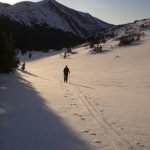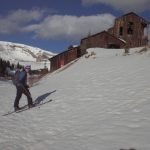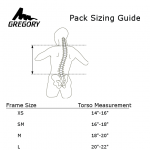If you like exploring and spending time in the mountains, you understand the desire and drive to get deeper into more beautiful and rugged terrain. To safely travel through complex mountain terrain you must safely navigate a not straight-forward route. Route Finding is a skill set common to all mountaineering, climbing and hiking disciplines.
Route finding is a core mountain skill set that requires constant improvement if bigger and more complicated mountain adventures are in your future.
Route finding skills will help you to:
- Safely navigate mountain terrain
- Improve mountain leadership skills
- Climb harder mountains
- Enjoy more adventurous trekking
Many peaks and backpacking treks require zero route finding, just follow the trail. For many people this level of mountain adventure is all the challenge and reward they need. However, the thrill of mountain climbing really begins when you start getting into 3rd & 4th class terrain. The path forward is not always obvious when in 3rd and 4th class terrain and big mountain exposure is to be expected.
Third and 4th class terrain is perfectly safe for most hikers if they understand what they are getting into and the conditions cooperate. Understanding the rating system for mountain terrain is critical. A hiker must be able to quickly identify 3rd class from 4th class and 4th class from 5.0 – if they are going to be in that terrain
A quick explanation of the rating system used to rank mountain terrain:
1st Class – Easy hiking and little consequence; perfect to take an out of town guest.
2nd Class – Slightly rugged terrain consists of steeper and rockier trails. Watch your step, but no scrambling at this level.
3rd Class – Terrain is steep and rugged, expect some easy scrambling moves. “Tough hiking” with possible exposure.
4th Class – Resembles climbing more than hiking. Careful hand and foot placement is required and each move carries the consequence of a fall if a slip occurs. Big mountain exposure.
5th Class – Technical rock climbing. Roped climbing. Ratings go “5.0” easy to “5.15” very hard.
On the surface, route finding is simple; getting from point A to point B by the safest and most efficient route possible. However, once you begin to dissect the different skills required to be a competent route finder, it is obvious that there is much more to it.
Here is what we will discussing the in the weeks to come:
- Risk assessment –Is the risk worth the reward? Everyone has a different level of risk they are willing to take while in the mountains. Risk assessment is critical not only to route selection, but a dynamic metric that is always turned on when moving through mountainous terrain.
- Thoroughly understand the objective –What does the peak look like from the trailhead? What landmarks are nearby? Are there shortcuts off the mountain? What is the most dangerous part of the route?
- Scope the route ahead– What is coming at you? Are some areas safer than others? Are there more hikers/climbers ahead on the route?
- Terrain reconnaissance– Where is the most stable rock? If possible avoid sections of loose rock, avoid being under sections of loose rock, avoid grabbing a loose rock. Where are the safe spots?
- Executing the route– Moving through mountainous terrain should be fun and worry free. Climbing is a very natural human movement; it is not to be over thought.
As you gain a better understanding of mountainous terrain and have the ability to safely climb more challenging routes, you will quickly see that climbing a mountain you once thought was impossible is one of the most rewarding feelings in hiking.
This is part one of a series of blogs dedicated to improving mountain skills.
If you are interested in learning more in the meantime check out the Colorado Mountain Club for classes.
https://www.cmc.org/Calendar/Classes.aspx






